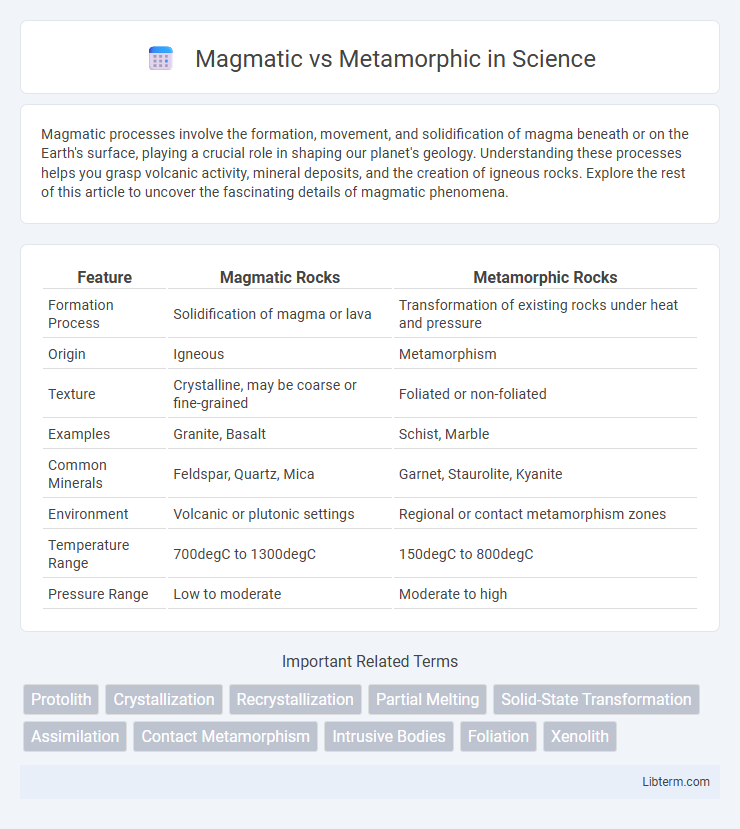Magmatic processes involve the formation, movement, and solidification of magma beneath or on the Earth's surface, playing a crucial role in shaping our planet's geology. Understanding these processes helps you grasp volcanic activity, mineral deposits, and the creation of igneous rocks. Explore the rest of this article to uncover the fascinating details of magmatic phenomena.
Table of Comparison
| Feature | Magmatic Rocks | Metamorphic Rocks |
|---|---|---|
| Formation Process | Solidification of magma or lava | Transformation of existing rocks under heat and pressure |
| Origin | Igneous | Metamorphism |
| Texture | Crystalline, may be coarse or fine-grained | Foliated or non-foliated |
| Examples | Granite, Basalt | Schist, Marble |
| Common Minerals | Feldspar, Quartz, Mica | Garnet, Staurolite, Kyanite |
| Environment | Volcanic or plutonic settings | Regional or contact metamorphism zones |
| Temperature Range | 700degC to 1300degC | 150degC to 800degC |
| Pressure Range | Low to moderate | Moderate to high |
Introduction to Magmatic and Metamorphic Rocks
Magmatic rocks, also known as igneous rocks, form from the solidification of molten magma either beneath the Earth's surface as intrusive rocks or after volcanic eruptions as extrusive rocks. Metamorphic rocks develop from pre-existing rocks that undergo physical and chemical changes due to intense heat, pressure, or chemically active fluids, often deep within the Earth's crust. Understanding the formation processes and textural characteristics distinguishes magmatic rocks like granite and basalt from metamorphic varieties such as schist and gneiss.
Definition of Magmatic Rocks
Magmatic rocks, also known as igneous rocks, form from the solidification of molten magma either beneath the Earth's surface as intrusive rocks or after volcanic eruption as extrusive rocks. These rocks are characterized by their crystalline texture, which develops as minerals crystallize from cooling magma at varying rates. Common examples include granite, basalt, and rhyolite, each reflecting distinct mineral compositions and cooling histories within the magmatic rock category.
Definition of Metamorphic Rocks
Metamorphic rocks form through the process of transformation of existing rock types, called the protolith, under intense heat and pressure conditions within the Earth's crust, without the rock melting. These rocks exhibit distinct mineralogical and structural changes, including foliation or recrystallization, which differentiate them from magmatic rocks that originate from the cooling and solidification of magma. Common examples of metamorphic rocks include slate, schist, and gneiss, each reflecting different degrees of metamorphism and geological environments.
Formation Processes: Magmatic vs Metamorphic
Magmatic rocks form through the cooling and solidification of molten magma or lava, either beneath the Earth's surface as intrusive rocks or on the surface as extrusive rocks. Metamorphic rocks develop when existing rocks undergo transformation due to intense heat, pressure, or chemically active fluids, altering their mineral composition and texture without melting. The key difference lies in magmatic processes originating from magma crystallization, whereas metamorphic processes involve the recrystallization of pre-existing rocks under solid-state conditions.
Mineral Composition Differences
Magmatic rocks typically contain primary minerals like quartz, feldspar, mica, and amphibole, formed from the cooling of molten magma, resulting in crystalline textures. Metamorphic rocks exhibit minerals such as garnet, staurolite, kyanite, and chlorite, which develop under high temperature and pressure conditions altering their original mineralogy. The mineral composition in metamorphic rocks reflects recrystallization and chemical reactions distinct from the original igneous or sedimentary parent rock.
Texture and Structure Comparison
Magmatic rocks exhibit interlocking crystalline textures formed from the solidification of molten magma, featuring coarse-grained textures like phaneritic or fine-grained aphanitic structures depending on cooling rates. Metamorphic rocks display foliated or non-foliated textures resulting from the recrystallization of pre-existing rocks under heat and pressure, often developing layered or banded structures such as schistosity or gneissic banding. Texture in magmatic rocks is primarily controlled by cooling history, while metamorphic textures reflect the intensity and direction of metamorphic forces.
Geological Environments and Settings
Magmatic rocks form in geological settings characterized by the cooling and solidification of magma, typically occurring in volcanic arcs, mid-ocean ridges, and hotspots where molten rock intrudes or extrudes from the Earth's mantle. Metamorphic rocks develop in environments subjected to intense heat and pressure, such as convergent plate boundaries, deep crustal roots of mountain belts, and regions affected by regional or contact metamorphism. These distinct geological environments dictate the mineralogy and texture of magmatic versus metamorphic rocks, reflecting their formation processes within Earth's lithosphere.
Key Identification Features
Magmatic rocks form from the cooling and solidification of molten magma, characterized by interlocking crystalline textures and often visible mineral grains such as quartz, feldspar, and mica. Metamorphic rocks result from the alteration of existing rocks under heat and pressure, displaying foliated or non-foliated textures with minerals like garnet, kyanite, and staurolite aligned in bands. Key identification features include the presence of igneous textures like porphyritic or glassy structures in magmatic rocks versus the layered mineral composition and re-crystallization effects in metamorphic rocks.
Uses in Industry and Construction
Magmatic rocks such as granite and basalt are widely used in construction for their durability and strength, commonly employed in building foundations, monuments, and road aggregates. Metamorphic rocks like marble and slate are prized in industry and construction for their aesthetic appeal and workability, often utilized in flooring, countertops, and decorative architectural elements. Both rock types provide essential materials with specific structural and visual properties that meet diverse engineering and design requirements.
Summary: Magmatic vs Metamorphic Rocks
Magmatic rocks form from the solidification of molten magma, classified primarily as intrusive or extrusive based on their cooling environment. Metamorphic rocks originate from the transformation of existing rocks under heat, pressure, and chemically active fluids without melting. Key differences include formation processes, texture, and mineral composition, with magmatic rocks showing crystalline textures and metamorphic rocks exhibiting foliation or banding.
Magmatic Infographic

 libterm.com
libterm.com